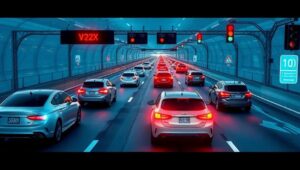The Future of Automotive IoT: Connected Cars and V2X (2026)
The automotive industry is undergoing a massive transformation, driven by the Internet of Things (IoT). Connected cars are no longer a futuristic concept; they are a present-day reality, and their evolution is rapidly accelerating. By 2026, the integration of IoT in vehicles will reach unprecedented levels, with Vehicle-to-Everything (V2X) communication becoming a standard feature.
What is Automotive IoT?
Automotive IoT refers to the network of interconnected devices and systems within a vehicle and its surrounding environment. This includes sensors, software, and communication technologies that enable cars to collect and exchange data, enhancing safety, efficiency, and the overall driving experience.
Key Components of Automotive IoT:
- Sensors: Collect data on vehicle performance, environmental conditions, and driver behavior.
- Connectivity: Enables communication between vehicles, infrastructure, and other devices via cellular, Wi-Fi, and Bluetooth.
- Data Analytics: Processes and analyzes collected data to provide insights and improve decision-making.
- Software Platforms: Integrate various IoT applications and services within the vehicle.
V2X Communication: The Next Frontier
Vehicle-to-Everything (V2X) communication is a pivotal aspect of the future of automotive IoT. It involves the exchange of information between a vehicle and its surroundings, including other vehicles (V2V), infrastructure (V2I), pedestrians (V2P), and the network (V2N).
Types of V2X Communication:
- Vehicle-to-Vehicle (V2V): Allows cars to communicate with each other, sharing data on speed, location, and potential hazards. This can help prevent collisions and improve traffic flow.
- Vehicle-to-Infrastructure (V2I): Enables vehicles to connect with road infrastructure, such as traffic lights, road sensors, and signage. This can provide real-time traffic updates and optimize routing.
- Vehicle-to-Pedestrian (V2P): Connects vehicles with pedestrians’ devices, such as smartphones and wearables, to alert drivers of nearby pedestrians and vice versa.
- Vehicle-to-Network (V2N): Connects vehicles to cloud-based services and data centers, providing access to navigation, entertainment, and remote diagnostics.
Expected Developments by 2026:
By 2026, several key developments are expected in the realm of automotive IoT and V2X communication:
- Enhanced Safety Features: V2X technology will enable advanced driver-assistance systems (ADAS) with features like cooperative adaptive cruise control, emergency braking, and lane-keeping assistance, significantly reducing accidents.
- Improved Traffic Management: Real-time traffic data and V2I communication will optimize traffic flow, reduce congestion, and minimize travel times.
- Autonomous Driving Capabilities: V2X will be crucial for the development of fully autonomous vehicles, providing them with the necessary data to navigate complex environments safely.
- Seamless Connectivity: 5G technology will provide faster and more reliable connectivity, enabling seamless data exchange between vehicles and their surroundings.
- Personalized Driving Experience: IoT will enable personalized in-car experiences, with customized infotainment, comfort settings, and driver assistance based on individual preferences.
Challenges and Opportunities:
While the future of automotive IoT is promising, there are challenges to address:
- Data Security and Privacy: Protecting vehicle data from cyber threats and ensuring user privacy is paramount.
- Standardization: Establishing common standards for V2X communication is essential for interoperability between different vehicles and infrastructure.
- Infrastructure Investment: Deploying the necessary infrastructure to support V2X communication requires significant investment.
Despite these challenges, the opportunities are immense. Automotive IoT and V2X communication have the potential to transform transportation, making it safer, more efficient, and more enjoyable.
Conclusion
As we approach 2026, the automotive industry is set to embrace the full potential of IoT. Connected cars and V2X communication will revolutionize the way we drive, offering enhanced safety, improved traffic management, and a more personalized driving experience. Overcoming the challenges and capitalizing on the opportunities will pave the way for a smarter and more connected future on the road.




